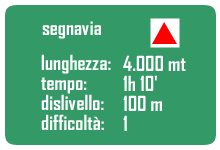Via Julia Augusta was built in 13 BC, under Emporer Augustus’s orders, so a sto connect Rome to Southern Gaul. The magnificent stretch of Via Julia Augusta between Alassio and Albenga is a historical, naturalistic and archaeological trail. It is easily covered on foot and is rich in colours and smells typical of Mediterranean vegetation.
From Alassio, the trail starts from th Santa Croce church, dating back to the I I th Century, from which you can enjoy an extraordinary view. Once you have passed a stone archway, you will see straight away the sights that will accompany you all the way along the trail: the sea and the island of Gallinara.
In the first stretch of road, the Alassio harbour dominates the view. The harbour was established in the 1950s where there was a small natural bay, featuring a picturesque Chapel erectded in 1929 in memory of those lost at sea. Only a few hundred metres away, amongst cypress and eucalyptus trees, is the Sant'Anna ai Monti church, which is, according to legend Alassio's oldest church, built before the year on thousand. After centuries of neglect, it was restored in 1968. It contains traces of frescos from the end of the 15th Century.
As the road goes on - surrounded by increasing thick vegetation - it provides wonderful, high views of the coast below. 3 km on, having passed a campsite, you can, in certain small stretches of the road, still appreciate the original Roman paving. Slightly further along, the ruins of a burial site mark the start of the Roman necroplis of Albingaunum, dating back the 1st-2nd Centuries AD.
Its remains span the remaining length of the route. Once you have passed a small bridge, you enter into the town of Albenga; below, you can catch a glimpse of the "Colombera", a beautiful sixteen-century residence, which is now neglected. When you have passed the other funerary monuments, you rich the tip of San martino, near the "Pilone", a tomb dating back to the 2nd Century AD, and to the Roman amphitheatre (both privately owned and accessible by taking a diversion). After a slight descent, and once you have passed the new bridge over the river Centa, you reach Albenga's town centre and its medieval towers.
View route: La Via Julia Augusta in a larger map
